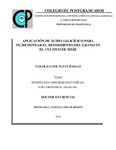| dc.contributor.author | Tucuch Haas, César Jacier | |
| dc.creator | TUCUCH HAAS, CÉSAR JACIER; 336993 | |
| dc.date.accessioned | 2019-07-30T16:03:18Z | |
| dc.date.available | 2019-07-30T16:03:18Z | |
| dc.date.issued | 2016-07 | |
| dc.identifier.uri | http://hdl.handle.net/10521/3735 | |
| dc.description | Tesis (Doctorado en Ciencias, especialista en Edafología).- Colegio de Postgraduados, 2016. | es_MX |
| dc.description.abstract | El maíz es el alimento básico de la población mexicana. Se estima que el 59 % de la energía consumida por los mexicanos es obtenida de esta gramínea. El aumento de la población en México en los primeros tres lustros, ha traído consigo un incremento en la demanda de este grano, a tal grado que, actualmente se importa el 19 % del total consumido. Bajo este contexto y dado que el ácido salicílico (AS) actúa como una hormona vegetal, regulando diversos procesos fisiológicos y bioquímicos, que desencadenan una cascada de respuestas benéficas en diversas especies de plantas; concentraciones de 0.01, 0.1 y 1 µM de AS se probaron, para medir su efecto en una variedad local de maíz (Xmejen-nal) del estado de Yucatán, cuando se aplica al dosel en etapa de plántula. Parámetros de crecimiento de raíz y vástago de plántulas de maíz, en condiciones controladas y a campo abierto, bajo un diseño completamente al azar fueron evaluadas; también, el estatus nutrimental y producción de grano en plantas adultas, en dos experimentos, dispuestas en bloques al azar a campo abierto. Se midieron además la fotosíntesis, transpiración y conductancia estomática en uno de los experimentos establecidos en campo y fenoles totales en el grano de ambos experimentos. Los resultados señalan que 1 µM de AS favorece significativamente la longitud de la raíz, la biomasa seca total, el rendimiento del grano y los contenidos de N, P, K en el follaje y el grano. Además favorece en 28 % la fotosíntesis y en 17 % la concentración de fenoles en el grano. _______________ APPLICATION OF SALICYLIC ACID TO INCREASE THE YIELD OF THE GRAIN IN THE MAIZE CULTIVATION. ABSTRACT: Maize is the staple of the Mexican population. It is estimated that 59 % of the energy consumed by Mexicans, is obtained from this gramineous. The population growth in Mexico in the first three decades has brought an increase in demand for this grain, insomuch that currently Mexico imports 19 % of its total consumption. In this context and given that salicylic acid (SA) acts as a plant hormone regulating various physiological and biochemical processes, which triggers a cascade of beneficial responses in various plant species; concentrations of 0.01, 0.1 and 1 µM of SA were tested to measure their effect in a local variety of maize (Xmejen-nal) from the state of Yucatan, when applied to the canopy in seedling stage. Root and stem growth parameters of maize seedlings in controlled conditions and in the open field under a completely random design were evaluated; furthermore, the nutritional status and grain production in adult plants, in two experiments, arranged in random blocks in open field. Photosynthesis, stomatal conductance and transpiration were measured in one of the experiments established to open field and, total phenols in grain were also measured in both experiments. The results indicate that 1 µM of SA contributes significantly to the root length, total dry biomass, grain yield and the contents of N, P, K in the foliage and grain. It also promotes photosynthesis by 28 % and 17 % phenol concentration in the grain. | es_MX |
| dc.description.sponsorship | Consejo Nacional de Ciencia y Tecnología (CONACyT). | es_MX |
| dc.format | pdf | es_MX |
| dc.language.iso | spa | es_MX |
| dc.rights.uri | http://creativecommons.org/licenses/by-nc-nd/4.0 | es_MX |
| dc.subject | Gramínea | es_MX |
| dc.subject | Zea mays | es_MX |
| dc.subject | Biomasa | es_MX |
| dc.subject | Estatus nutrimental y fenoles | es_MX |
| dc.subject | Gramineous | es_MX |
| dc.subject | Root | es_MX |
| dc.subject | Biomass | es_MX |
| dc.subject | Nutrimental status and phenols | es_MX |
| dc.subject | Edafología | es_MX |
| dc.subject | Doctorado | es_MX |
| dc.subject | Estrés biótico | es_MX |
| dc.subject | Biotic stress | es_MX |
| dc.subject.classification | CIENCIAS AGROPECUARIAS Y BIOTECNOLOGÍA::CIENCIAS AGRARIAS::AGRONOMÍA::SEMILLAS | es_MX |
| dc.title | Aplicación de ácido salicílico para incrementar el rendimiento del grano en el cultivo de maíz. | es_MX |
| dc.type | Tesis | es_MX |
| Tesis.contributor.advisor | Alcántar González, Gabriel | |
| Tesis.contributor.advisor | Larque Saavedra, Alfonso | |
| Tesis.contributor.advisor | Salinas Moreno, Yolanda | |
| Tesis.contributor.advisor | Volke Haller, Víctor Hugo | |
| Tesis.contributor.advisor | Trejo-Téllez, Libia Iris | |
| Tesis.date.submitted | 2016-07 | |
| Tesis.date.accesioned | 2016 | |
| Tesis.date.available | 2016 | |
| Tesis.type | Tesis | es_MX |
| Tesis.format.mimetype | pdf | es_MX |
| Tesis.format.extent | 1,012 KB | es_MX |
| Tesis.subject.nal | Ácido salicílico | es_MX |
| Tesis.subject.nal | Salicylic acid | es_MX |
| Tesis.subject.nal | Ácido abscísico | es_MX |
| Tesis.subject.nal | Abscisic acid | es_MX |
| Tesis.subject.nal | Ensayos de variedades | es_MX |
| Tesis.subject.nal | Variety trials | es_MX |
| Tesis.subject.nal | Especies nativas | es_MX |
| Tesis.subject.nal | Indigenous species | es_MX |
| Tesis.subject.nal | Fotosíntesis | es_MX |
| Tesis.subject.nal | Photosynthesis | es_MX |
| Tesis.subject.nal | Transpiración | es_MX |
| Tesis.subject.nal | Transpiration | es_MX |
| Tesis.subject.nal | Conductancia estomática | es_MX |
| Tesis.subject.nal | Stomatal conductance | es_MX |
| Tesis.subject.nal | Fertilizantes NPK | es_MX |
| Tesis.subject.nal | NPK fertilizers | es_MX |
| Tesis.rights | Acceso abierto | es_MX |
| Articulos.subject.classification | Maíz-rendimiento | es_MX |
| dc.type.conacyt | doctoralThesis | es_MX |
| dc.identificator | 6||31||3103||310311 | es_MX |
| dc.contributor.director | ALCÁNTAR GONZÁLEZ, GABRIEL | |
| dc.audience | generalPublic | es_MX |


